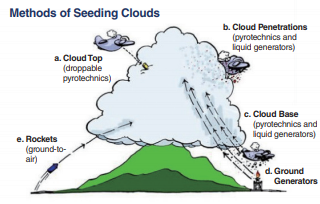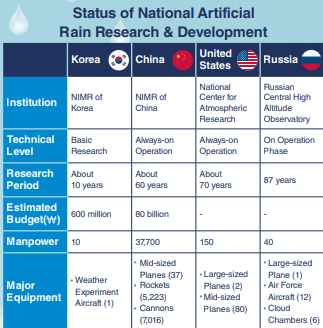There are only a few days when we can see a clear blue sky these days, because of the fine dust which has covered the whole of Korea. In search of a solution to the pervasive fine dust, the Korean government conducted an artificial rain experiment on January 25th over the West Sea to analyze its effects. Artificial rain is not only used for drought resolution, just one of its many practical uses, but can also be used for the reduction of fine dust. Therefore, the Sungkyun Times (SKT) decided to look at the principles of artificial rain, its problems and limitations, and possible solutions.
The Principle of Artificial Rain
Artificial rain refers to man-made rainfall. In order to create artificial rain, cloud seeds which are chemical compounds that can become ice nuclei and condensation nuclei, are sprayed into the atmosphere to form water vapor condensation and eventually bring rainfall to the ground. Ice nuclei are particles in the atmosphere that help form ice crystals like snowflakes. Condensation nuclei are small solids which become centers when water vapors condense with each other. After spraying these chemical clouding seeds on clouds containing enough water vapor, the water vapor particles gather up, and water droplets begin to grow larger and heavier, eventually producing rain.

Therefore, there are two ways of making artificial rain. The first one is by spraying ice nuclei and the second one is by spraying condensation nuclei. The first method is to spray ice nuclei, like silver iodides (AgI), on cold clouds (below 0℃). After spraying ice nuclei, water vapors adhere to the particles of sprayed silver iodides and the cold air transforms these combined particles into small ice crystals. Then, more water vapors are combined into these ice crystals and eventually become heavy snowflakes. These snowflakes start to fall due to their heavyweight, melt in the middle of the clouds, and become rain. The artificial rain experiment, which was conducted in Korea on January 25th, practiced this method of spraying silver iodides into the clouds by aircraft. The second method of spraying condensation nuclei, is to spray condensation nuclei, such as calcium chloride (CaCl2) and sodium chloride (NaCl), on warm clouds over 0℃. Condensation nuclei accelerate the procedure of water vapor condensation around clouds and create water droplets. There are also five other methods for spraying cloud seeds: cloud top, cloud penetrations, cloud base, ground generator, and rockets. The need for the artificial rain tends to decide the method. For example, to make artificial rain for a resulting clear sky, using the rocket method to spray the cloud seeds into the clouds is the most common. This artificial rain technology can be used for various purposes: to prevent damage from natural disasters such as droughts and frequent floods due to severe weather phenomena, and to suppress massive forest fires and, of course, to reduce fine dust.

The Obstacles of Artificial Rain Development
➊ Cost and Budget Issues
One of the biggest hindrances is the budget problem. At least 35 researchers are required for basic artificial rain experiments. Advanced equipment for aviation experiments is also mandatory. In particular, the exclusive use of aircraft which are highly mobile is needed to spray cloud seeds over a short period of time on specific clouds that contain enough water vapor. Therefore, it takes a lot of money to obtain highly mobile aircraft. Besides this, since the cloud seeds like silver iodide are silver compounds, the seeds are highly expensive. These expensive cloud seeds increase the total cost of artificial rain experiments. If the experiment fails, the investment budget is essentially just evaporating into the middle of the sky. According to the Korea Meteorological Administration (KMA), at the West Sea experiment on January 25th, about 7.2 million won was spent for 24 rounds of silver iodine, which costs 300,000 won per shot. In other countries, they use hundreds of times more silver iodine to conduct experiments at great expense. Alan Robock, a professor in the Department of Environmental Sciences at Rutgers University in the United States, calculated the estimated cost of spraying cloud seeds in the stratosphere to amount to approximately six to eight billion dollars per year.
➋ Natural Restrictions
Artificial rain on a cloudless dry day is impossible. Moreover, present artificial rain technology cannot bring rainfall to just any places that the researchers want. Since people cannot produce new water vapors in the atmosphere, it is necessary to find clouds with high moisture in the sky. It is, however, difficult to find these kinds of clouds, and transform moving clouds into water droplets.
➌ Environmental Issues
According to a Japanese agricultural science foundation, silver iodide has a weak toxicity itself. Although it has less impact on the environment compared to other heavy metals, it takes a long period of time to be completely absorbed into the ground. Therefore, there is a possibility for soil pollution which can affect soil and marine organisms, including humans. Also, it can cause problems of environmental hormones from chemical compounds. Masataka Murakami, a professor at Nagoya University in Japan, says that “if artificial rain is successful in some countries, neighboring countries can be negatively affected from the chemical compounds used in experiments, which can cause environmental pollution.” Moreover, artificial rain transforms the moving clouds into water droplets instead of drifting to other countries, which can cause drought in neighboring countries.
The Present and Future of Artificial Rain in Korea
The Limitations of Developing Artificial Rain in Korea
For the past 10 years, from 2008 to 2018, the National Institute of Meteorological Research (NIMR) in Korea has conducted only 54 artificial rain experiments. It is such a small number compared to other developed countries, which shows that Korea does not have enough experimentation experience. Lots of trial and error experiences would help researchers to figure out the amount of cloud seeds that should be used for effective and optimized artificial rain.
In addition to the latest experiment in Korea, 42 artificial rain and snow experiments have been conducted in metropolitan areas, like the Yeongdong area and inland areas in Gyoengsangbuk-do. There, however, have only been 16 examples of successful experiments. Subsequently, Korea’s maximum goal is to maintain 10 millimeters precipitation for two hours. On the other hand, other countries which are more developed in terms of their weather control systems already have a technology that artificial rain lasts for two to three days with more than 10 millimeters of precipitation. According to a technology level evaluation report in 2016 from the Korea Institute of Science & Technology Evaluation and Planning (KISTEP), Korea’s artificial rain technology level was 73.8% of the technology used by the United States (US), and the technological gap between the US and Korea was about 6.8 years. The report suggested that Korea’s technology was only at the level of mere imitation of developed countries’ technologies.
The main reason for these limitations is low budget. NIMR’s budget for artificial rain is only 900 million won a year, and there are only 10 researchers for research and development (R&D). In particular, the R&D budget is about 600 million won a year, which is not sufficient enough to conduct the experiments with clouds that move and change from time to time. Moreover, considering the additional costs of cloud observation before the experiments, simulation experiments and related equipment development.
Possible Solutions for Korea
At first, more investment and support for artificial rain are necessary by gradually increasing the R&D budget of NIMR. In the case of Korea, only 10 researchers and one exclusive aircraft were available in 2015. China, on the other hand, invests 80 billion won into its R&D budget and has 37,700 researchers for artificial rain research. It also has 37 aircraft for weather experiments and holds 5,223 rockets that can fire cloud seeds from the ground level. As much as an increasing investment is important, reducing experiment costs is also essential. One way to reduce costs would be to develop Korea’s own cloud seeds. Since most of the cloud seeds are imported, it is quite expensive to buy for every experiment. If Korea successfully develops its own cloud seeds, experiment costs would decrease dramatically, which could lead to Korea’s own unique development of artificial rain. The other way is to develop drones that can spray cloud seeds in the air. The development of drones is expected to reduce the budget for buying aircraft and enable more accurate observations. Lastly, training professional researchers and establishing an independent experiment center only for artificial rain technology development are also necessary for the bright future of Korean artificial rain.

In fact, artificial rain experiments are still more ineffective than the costs invested. Also, Korea’s research into artificial rain has only existed for about 10 years. Therefore, it is hard to expect immediate improvements. Nevertheless, whether it has practical value or not, artificial rain is a necessary technology to deal with the incoming abnormal severe weather. Hence, the investments and researches should be supported to accomplish the technology at the national strategic level. Moreover, Korea should develop its own artificial rain technology with accumulated data, not just being optimistic and pessimistic at every success and failure.
